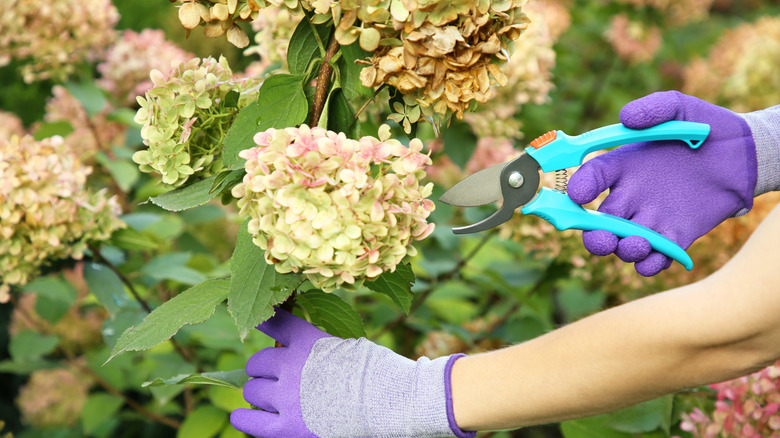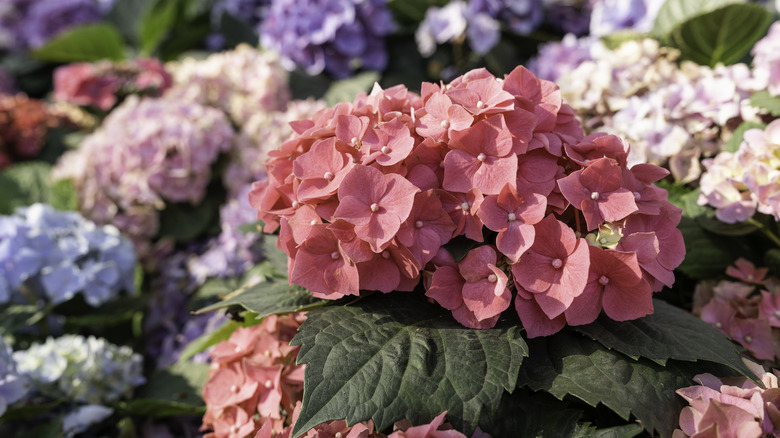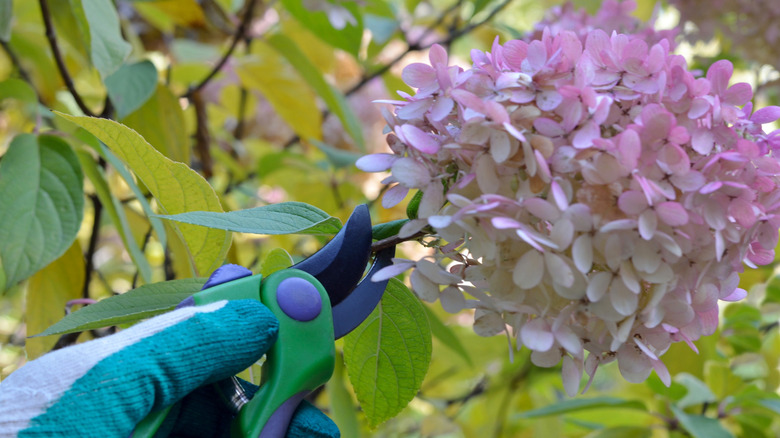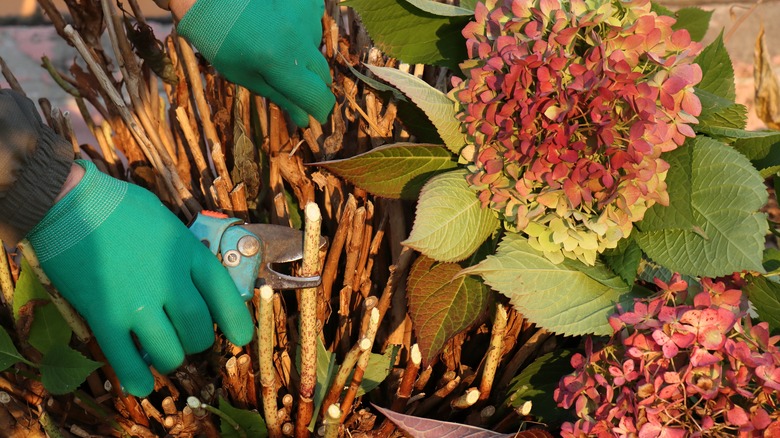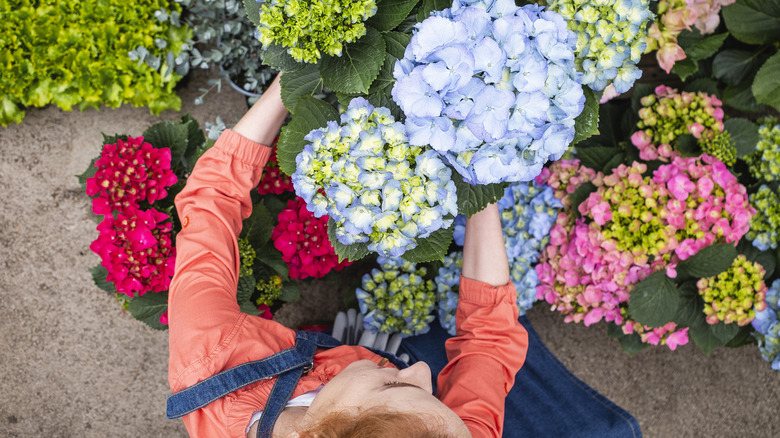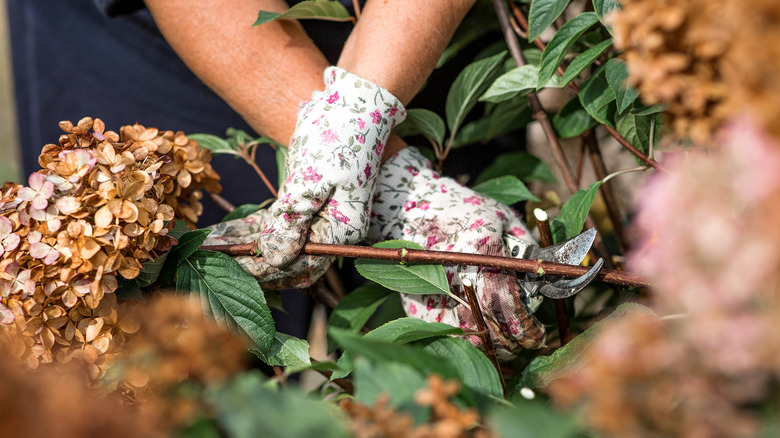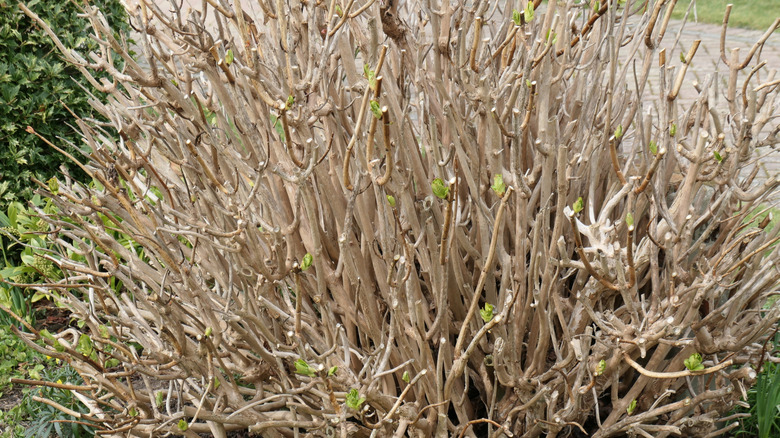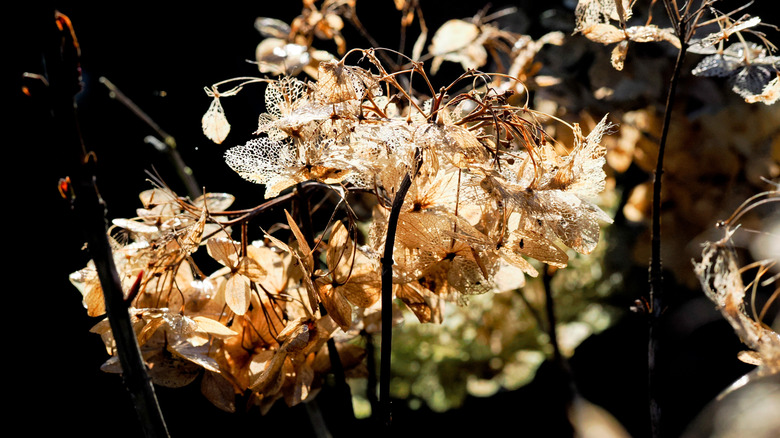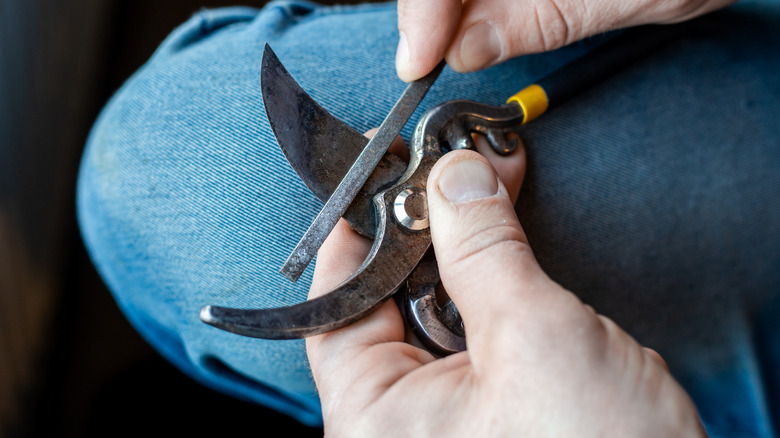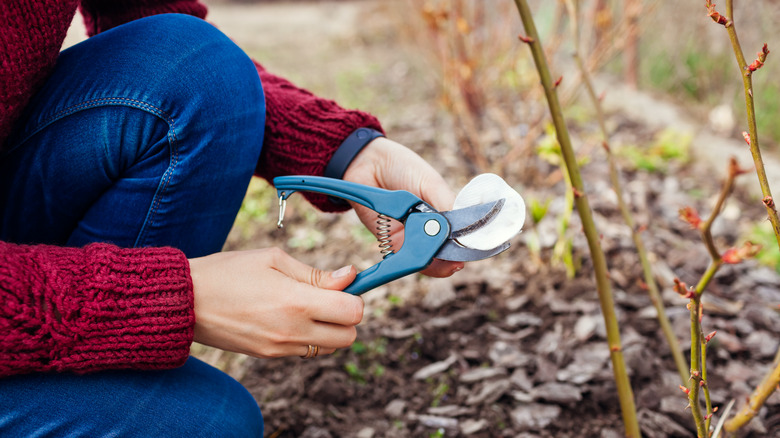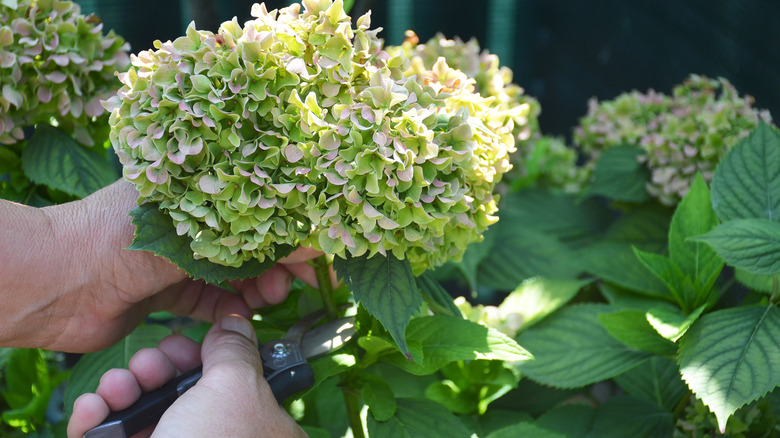Avoid These Hydrangea Pruning Mistakes Or Say Goodbye To Beautiful Blooms
We may receive a commission on purchases made from links.
What's prettier than a hydrangea in full bloom? Not much — at least in our opinion. Those bright, bushy plants full of flowers and foliage are a welcomed sight after a rough winter, and we're here to ensure you get the maximum amount of blooms possible. Unfortunately, some gardeners can accidentally cause their hydrangea bushes to back off on producing flowers by doing one or two small things wrong that end up having big consequences.
That's why we've rounded up the top pruning mistakes that might result in a sadder-looking bloom season for your plant. Plus, we'll dive into a few ways you can avoid each issue, or what to do to fix it (if it's fixable). These mistakes center around when to prune, how much to remove, and the tools you use. No matter the type of hydrangea you have growing in your yard, you're sure to find one reason to change your pruning routine or give yourself a gold star for learning you've done it the right way all along.
Which hydrangea do you have?
Before we get into the nitty-gritty, you'll first need to find out which hydrangea you have, as different species require different pruning techniques for maximum flower production. The easiest way to do this is by taking a look at its flowers. Hydrangea macrophylla, also known as "bigleaf," "French," or "mop head" hydrangeas, are the most common and have blue or pink-hued flowers that can change color based on your soil's pH levels. Hydrangea quercifolia, or "oakleaf hydrangeas," have white flowers that bloom in cone shapes and may fade to pink, depending on the cultivar. Hydrangea paniculata, also known as "peegee hydrangeas," have pinkish-white flowers and toothed leaves that grow in triads or pairs.
There are also a few less-common varieties that you might come across: H. arborescens is a smaller plant than other hydrangeas and has large white or pink flowers that may bloom later than others, usually around mid-summer. H. serrata, also known as "mountain hydrangea," has much smaller leaves and narrower flowers than others, but the same coloring as H. macrophylla. H. barbara and H. anomala are both climbing hydrangeas that need something to attach themselves to before showing off their pretty white flowers. Okay, now that we've got that sorted, let's dive into hydrangea pruning mistakes that could be costing you blooms.
Pruning at the wrong time of year could result in less, or no, blooms next season
Not all hydrangeas bloom at the same time, which makes them great for gardeners who want an extended season of hydrangea flowers, but bad for those who don't know which bloom time they're dealing with. Unfortunately, pruning your hydrangea bush at the wrong time can mean you're accidentally removing flower buds your plant needs for bloom production for the next year. The result? If you're lucky, you'll still get a few flowers, but most likely you'll have nothing but a big, green bush that's got to wait until the next bloom season before its flowers can come back.
Generally speaking, hydrangeas fall into two categories: spring or summer bloomers. "Spring blooming" is a bit of a misnomer, since it more refers to the time when new wood grows and most won't bloom until around June — but we don't make the naming rules for categories, so bear with us. Spring bloomers like H. macrophylla, H. quericifolia, H. serrata, and the climbing hydrangeas should be pruned immediately after flowering or you risk cutting off newly-formed flower buds that have developed on already-grown stems. Summer-blooming hydrangeas like H. paniculata or H. arborescens can be pruned in late winter or very early spring.
Pruning all hydrangeas the same way can mean some hydrangeas don't have time to make new blooms
Much like the time of year, the way to correctly prune your hydrangea varies based on the variety you have, and your method can either encourage or prevent more blooms altogether. For some varieties, pruning too far down the branch can result in cutting off newly-formed flower buds that develop on old growth. On the other hand, some varieties won't bloom as well as they did last season if there's too much old growth or stems getting in the way. Some hydrangeas can also be cut down to the ground to protect them from winter weather, while others need a more gentle approach where pruning is done in a staggered way over years — both of these, if done on the wrong hydrangea, can affect your bush's chances for blooms for the next year or even possibly multiple years.
H. paniculata and arborescens are the only two varieties that can take a hard pruning and flourish the next season; prune these down to the lowest pair of healthy-looking buds you can find. H. macrophylla, serrata, quercifolia, and the climbers need a gentler touch to keep producing flowers. Trim these to just under the flower cluster only and leave as much stem as you can during their growth season to keep them blooming as long as possible. It's also okay to trim any dead or winter-damaged stems or foliage you notice. After that, leave them alone until spring, when you'll remove any remaining dead flower heads and cut back stems only to the first strong, healthy-looking pair of buds you see.
Ignoring the type of wood the hydrangea blooms on may mean no blooms at all
Time of year, method, etc. — it's all a lot to remember, isn't it? If you want to skip that, just keep this mistake in mind, because it's a big one. Accidentally pruning off the wrong type of wood on a hydrangea can result in missing out on any blooms the next year. Some types of hydrangea will produce flowers on old wood, while other types need new stems to grow new flowers. Getting this one wrong is a big reason why gardeners lose multiple flowering seasons with their hydrangeas, so knowing what type of hydrangea you have, and pruning accordingly, is essential to protecting your bloom production.
"Wood" refers to the branches and stems of the hydrangea, in case that wasn't clear. Hydrangeas that are considered "old wood" types — like H. macrophylla, quercifolia, serrata, and the climbers — all utilize wood that's already there to put out new flower buds. These will usually begin toward the end of summer and into fall, lying dormant in the winter until they're back in the growing season. Meanwhile, "new wood" types, like H. arborescens and paniculata, need fresh branches (that have sprouted during the current growing season) to flower on and don't have to worry about winter dormancy for their buds; they just pop up when the new wood is ready to support them. There are also new types on the scene called "remontant," which means they can produce flowers on both old and new wood. Obviously, these would be the most forgiving to deal with, but can be hard to come by if you're not paying attention to the nursery tag, and might be more expensive because of their bountiful nature.
Using improper pruning techniques can stop new hydrangea blooms the following year
When you think of pruning, you probably picture cutting off dead stuff or hacking a plant to bits, but there are different techniques that not only affect your hydrangea's shape, but also its ability to grow more flowers. Pruning a hydrangea too much can stop it from growing and producing more blooms. That's why it's important to understand the different types of pruning cuts, and when to use them, so that your hydrangea bush can produce as many healthy flowers as possible.
As mentioned before, new wood types of hydrangeas are a little more forgiving and are usually okay with being trimmed back closer towards the ground (just don't go below the last bud or growth node). However, we want to emphasize that this depends a lot on the age, health, and growing conditions – not all new woods are guaranteed to come bouncing back after an overly severe prune. For all hydrangeas, though, there are a few techniques you can borrow from pruning woody trees and shrubs that help give the hydrangea more blooms and keep the whole plant healthy. "Heading back" cuts, or pruning cuts that trim stems into a stub, are a technique used to encourage bushy, vigorous growth of foliage and flowers. "Thinning out" cuts — cuts that shorten a branch's length or the amount of offshoot branches — are used to trim an overgrown hydrangea that may have trouble getting enough light to its lower buds closer to the ground. If your hydrangea is starting to get more woody than lush, thinning out cuts are probably the safer bet. Heading back cuts should only be used if you're certain you've got a new wood bush that's healthy and can withstand the stress of losing a fair amount of its growth and be able to push out lots of new shoots.
Over-pruning can stress hydrangeas, reducing their ability to bloom
We know that sometimes you'll need to prune your hydrangea bush to keep it tidy or to remove any dead parts. Be careful when doing this, though, as too much pruning is a common mistake gardeners make with hydrangeas that can cause it to lose the buds it's already grown that are lying dormant. The result is at least one season with fewer blooms while the plant works on developing new growth for the buds to form on.
This mostly applies to old wood types of hydrangeas, which also happen to be the most well-known and commonly planted, so over-pruning is likely an issue you could face. If you're not confident in your pruning skills or hydrangea identification, that's okay! Stick to a simplified method and save your pruning for only dead or diseased branches and leaves; your hydrangea should be able to take things from there. You can also prune off any dead flowers regardless of the type of hydrangea you've got. Finally, give your hydrangeas at least one full growing season to settle in after planting before hacking away with the shears.
Under-pruning can lead to less blooms around the bush
While most hydrangeas don't need a lot of pruning, there are some reasons being too neglectful can cause your plant to miss its bloom season. Proper pruning will stimulate new growth — including more flowers — on hydrangeas, while under-pruning can weaken their ability to flower, especially if the plant is suffering from weather damage or disease. Also, crowded and overgrown hydrangeas can lead to higher chances of diseases developing that affect the bushes' health, diverting energy that should've been spent on producing flowers into keeping the plant alive.
Let's cover the latter reason first, because it's one not many think about until it's too late. Hydrangeas love water — it's there in the name — but trapped water is a problem. See, all of that lush, bushy growth can reduce air circulation throughout the plant, leading to excess moisture. Excess moisture can exacerbate diseases like powdery leaf mildew, havoc-wreaking leaf spot, and bacterial wilt, all of which can cause your hydrangea to pull its resources into fighting the infection instead of growing new flowers.
But what about letting your hydrangea run wild — why is that a problem? Well, climbing varieties can get leggy if they're not pruned back occasionally and won't flower at all if left on the ground, so prune off whatever trailers you see in the dirt. For the shrub types, leaving them to the whims of nature can result in healthy plants, but giving them a careful rejuvenation prune not only lets the plants shake off the old or damaged foliage, but stimulates more growth and helps them create even more flowers than the season before. Rejuvenation pruning is the practice of entirely removing dead or weak stems by cutting them back to the ground, but leaving healthy ones intact. So, don't go crazy with your pruning chores, but don't completely skip them, either.
Using dull tools can make it difficult for hydrangeas to have strong flowering branches
When is the last time you sharpened your pruning shears? If you can't remember, then it's time to give them a good sharpening. Using dull pruning blades can damage or even crush hydrangea tissue, making it more difficult to produce flowers, because the energy previously saved for blooming now has to go to repairing the damaged stem or branch. Plus, open wounds that take longer to heal can make your hydrangea susceptible to infections from diseases, further reducing its health and making it less likely to have enough energy to push out new flower clusters. Finally, a crushed stem is more likely to die back to a lower growth node, which will directly rob you of any flowers that were going to develop from the node which you cut just above.
The best method for sharpening garden shears is by using a sharpening stone, like the Sharpal 121N Dual-Grit Diamond Sharpening Stone File. You might hear that aluminum foil is the secret solution to dull pruning shears, but it doesn't actually sharpen garden blades but instead just helps to remove rust and buildup. Disassemble the shears, if you can, and run the file or stone along the cutting edge, keeping it at the same angle as the bevel. Once they're sharp enough to cut through paper, the shears are ready to use on your hydrangea plant.
Not cleaning your pruning tools can spread diseases that weaken hydrangeas
Cleaning your pruning shears before and after cutting your hydrangeas is important for ensuring you get the maximum amount of blooms possible. If you use rusty or dirty pruners on your hydrangea, it can result in the plant needing to divert energy toward fighting off any bacteria or diseases that may have been transferred from an infected plant to the shears, leaving less energy for bright, healthy flowers. Some types of diseases, like botrytis blight, bacterial wilt, and virescence can directly affect flower buds. For instance, virescence can manifest as stunted blooms, or the presence of leaf shoots where the flowers usually would be. All of this could result in fewer blooms during the growing season or might even kill off your hydrangea, in the worst-case scenario. So, keep your hydrangea healthy by cleaning your tools and you'll be rewarded with lush flower clusters every year.
There are lots of hacks to remove rust from your garden tools using things most likely already in your kitchen. As for sterilizing, a simple alcohol wipe works fine, but a 10% bleach solution (nine parts water to one part beach) is okay, too. Also, while it's not related to flowers specifically, cleaning your tools after a good hydrangea prune can be beneficial for your health, too. Some hydrangeas contain cyanogenic glycosides, a toxic chemical for humans and pets, so cleaning the residue off your tools ensures you keep yourself and loved ones safe.
Deadheading at the wrong time will make it harder for some new blooms to flower
Let's face it, dead flowers aren't pretty. But before you start deadheading your plants in the garden, check which time of year it is, because your hydrangeas might need them to survive. For climates that have harsh winters, deadheading hydrangeas can make it difficult for them to have enough protection from the winter, lowering the amount of energy they have the following year to produce flowers. Meanwhile, leaving spent flower heads on for too long can result in energy getting pushed toward seed production instead of flowers, also resulting in fewer blooms. Pruning dead flower heads from hydrangeas requires a little planning to ensure the plant's health and flower-producing energy aren't zapped by the time it's ready to bloom.
Old wood hydrangeas are particularly finicky about their faded flowers, because they act like protection for dormant baby flower buds — the massive ball clusters create a canopy that shields them from harsh winds and cold temperatures. New wood or remontant plants can handle deadheading a little better, but their ability to bounce back will depend on their health throughout the winter. If you want to give your hydrangea the best chance at another glorious blooming season, and live in a cold area, put the shears away around autumn and use winter protection wraps or bring container-bound hydrangeas inside. If your hydrangea happens to bloom during a random warm period in the winter, nip that in the literal bud and cut it back carefully; the damage from frost can harm the new and dormant buds, resulting in no flowers during the next bloom season.
